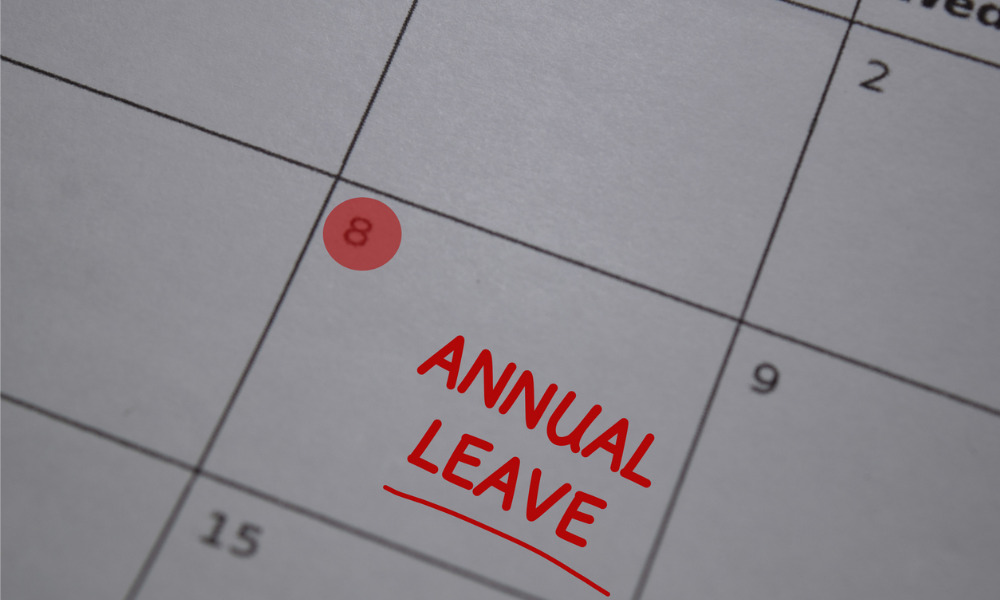
What if some employees refuse to use up their annual leave credits?

Annual leaves are essential components of a healthy work-life balance – but what if some employees refuse to use their annual leave credits? Can and should employers force those workers to use them?
Below, we look at the definition of annual leave and whether employers should be worried when their employees do not use them.
Read more: Westpac NZ expands employee leave benefits
Annual leave – also known as holiday pay or annual holidays – allows employees to take time off from work while still getting paid wages. Companies usually spell out the terms and conditions for annual leave in employment agreements and employee handbooks.
And employees can go on annual leave for various reasons, whether for rest, travel, personal development, or other personal reasons.
Employees who have worked continuously for 12 months are entitled to four weeks of paid annual leave every year, and they can start taking these leaves on the first anniversary of their employment.
If an employee has been working for a company for less than a year, they are not entitled to annual leave – but their employer may allow them to use some annual leave credits in advance.
And in limited circumstances, some employees may be paid holiday pay at the rate of not less than 8% of their gross earnings with their regular pay instead of being provided with four weeks’ annual holidays each year.
This pay-as-you-go scheme can only be done if the employee is on a genuine fixed-term agreement of fewer than 12 months, or the employee works irregularly that it is impractical for the employer to provide annual leave.
If an employee’s job ends before they can become entitled to annual leave – and the employee is not under a pay-as-you-go scheme – the employer must pay out any outstanding annual holidays at 8% of the employee’s total before-tax earnings between their first and last day on the job.
Employees who have a predictable work schedule get four of their working weeks as paid annual leave. For example, an employee who works three days a week is entitled to have 12 days of annual leave credits.
Meanwhile, employees who have no fixed work schedule, such as employees who only work when a job is offered or who work in a roster schedule that changes frequently, should work with their employer to try to identify a pattern of work that could be used to map out a working week for annual leave entitlements. For example, the work pattern could be based on the agreed hours in the employment agreement and the consideration of the days and hours the employee has been working in the weeks leading up to the holiday.
Moreover, annual leaves don’t expire if employees don’t take them – they remain entitled to them until they either use them or their employment ends.
Read more: Retail giant revamps leave policy to curb absenteeism
Employees cannot be forced at short notice to go on annual leave. However, according to the Holidays Act, an employer can compel workers to use them after giving 14 days’ written notice if a consultation between the two parties fails to reach an agreed conclusion and after considering the personal needs of the employee and the interests of the business.
Employees can also be obliged to take annual leave over any annual closedown period provided employers give 14 days’ written notice. For example, employers can notify their employees in early December or late November of the need for them to take annual leave during the Christmas period.
However, employers who have annual closedowns should keep in mind the payment rules for both employees with entitlements to go on annual leave and those without.
Human resource leaders can encourage and empower employees to take up unused paid leaves by ensuring managers and leaders are using up their annual leave. Companies should tell leaders that they need to take some days off and use their annual leave credits to recharge and enjoy their time away from work.
“It’s a simple but very powerful message,” Shubha Shridharan, senior vice president at the Adecco Group, tells HRD. “When people see that, they’ll think, okay, regional presidents and senior leaders can do it, so can I. In some ways, we are also implicitly encouraging our people to go into [rest] mode.”
Employers can also review the rules around booking leave and explore different ways to make it easier for employees to book leave. Using a system that employees can access anywhere that automatically notifies managers can encourage them to take leaves more often. Openly talking about the benefits of taking holiday leave with employees and sending out regular reminders of how many leave credits they have left in the year can also motivate them to plan annual leaves.
Employees who aren’t maximising their annual leave may not seem alarming, but it could be a symptom of a bigger problem in the workplace such as work overload or presenteeism. Smart HR leaders should investigate any trends building in their workplaces to find out why employees aren’t taking their leaves.